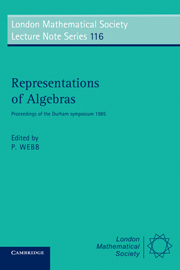Book contents
- Frontmatter
- Contents
- Introduction
- Representation theory of finite-dimensional algebras
- A survey of existence theorems for almost split sequences
- Representations of posets and tame matrix problems
- Geometry of representations of quivers
- Cohen-Macaulay modules on hypersurface singularities
- Almost split sequences and algebraic geometry
- Representation rings of finite groups
Geometry of representations of quivers
Published online by Cambridge University Press: 01 March 2011
- Frontmatter
- Contents
- Introduction
- Representation theory of finite-dimensional algebras
- A survey of existence theorems for almost split sequences
- Representations of posets and tame matrix problems
- Geometry of representations of quivers
- Cohen-Macaulay modules on hypersurface singularities
- Almost split sequences and algebraic geometry
- Representation rings of finite groups
Summary
INTRODUCTION
One of the first results about representations of quivers was Gabriel's characterization of the quivers of finite representation type and of their indecomposable representations [G1, G2]: The underlying graph of such a quiver is a union of Dynkin diagrams and the indecomposables are in one-to-one correspondence with the positive roots of the associated semisimple lie-algebra. Later Donovan-Freislich [DF] and independently Nazarova IN) discovered analogous relations between tame quivers and extended Dynkin diagrams. Since all remaining quivers are wild, there was little hope to get any further, except maybe in some special cases. Therefore Kac's spectacular paper [K1], where he describes the dimension types of all indecomposables of arbitrary quivers, came as a big surprise. In [K2] and [K3] Kac improved and completed his first results.
These notes are meant to be a guide to and through Kac's articles. In fact, most definitions and results are taken from his work. We reorganized them to give - we believe- a direct approach which is easy to follow. We refer to Kac's papers only for statements we do not prove completely.
Our point of view is of geometric nature -like in Kac's original work- and we use methods from algebraic geometry and transformation groups. The set of representations of a fixed dimension type is viewed as an algebraic variety on which the algebraic group of base change operators acts.
- Type
- Chapter
- Information
- Representations of AlgebrasProceedings of the Durham Symposium 1985, pp. 109 - 146Publisher: Cambridge University PressPrint publication year: 1986
- 16
- Cited by

